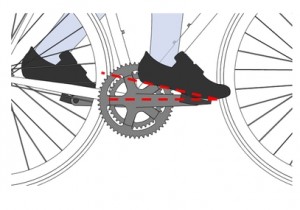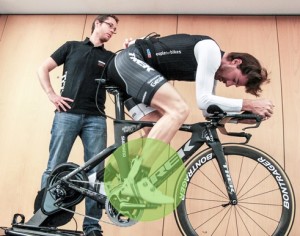Cycling Insoles: Hidden forces inside the shoe
In one of our first blog entries, I’ve written about an Australian study that analyzes foot pain in cycling. It became clear this is an important topic in bikefitting as more than half of the study participants were suffering from foot pain. We’ve also already covered the relevance of the cycling shoe in another blog entry. Now, it is time to consider the shoes’ insides, that is, the insole.
The positioning of the foot
The foot–shoe–pedal interface is a special one when compared to other sports. While the runner uses the heel as point of contact and rolls across the entire foot up to the base of the toes in every single strike, the cleats affix the ‘cycling-foot’ in the area of the ball of the foot. Even when using the maximum range of rotation offered by the cleats, the feet’s inward and outward rotation is limited. The freedom of the heel to move upward and downward is additionally limited by the saddle height, that is, the anchorage of the hip on the saddle. Accordingly, running insoles are no cycling insoles.
This special foot positioning results in sport-specific strain:
• The points of pressure within the cycling shoe are nearly identical in every pedal stroke.
• The feet’s force distribution is centred towards the front (region of the ball of the foot/ base of the toes).
• The area of contact is smaller, the heel has no direct contact.
• The forces are applied on the feet over an extended period (of possibly several hours).
Foot evaluation
In order to provide a fitting insole, both feet need to be analysed intensely. What is specific about each foot? Determining the foot type, the length and height of the longitudinal arch and examining the five metatarsal bones is important for later building a fitting insole. The foot as such is telling its own ‘strain-history’. In analyzing the foot, measurement technique can support the trained eye. In my opinion, a lot of information can be derived from a foot scan.
Upside and Flipside – Both are important!
Most of the currently available insole-concepts merely consider the insole’s upside. From my perspective, this disregards a decisive factor, namely the insole’s flipside: optimally, the flipside should fit the upside of the shoe sole without any gaps or overlaps. Ideally, they should be the sole’s negative. This becomes especially important when working with hard materials like carbon: If two items made of hard material (shoe sole + insole) lay on top of each other but are not adapted to each other, this can quickly cause undesired points of pressure on the sole of the foot. We were able to repeatedly visualize this phenomenon with our foot pressure measurement during bikefittings. To summarize: On its upside, the insole needs to fit the foot and on its flipside, it needs to fit the cycling shoe!
Weight of the material
The question of weight is decisive when it comes to components related to the foot–pedal interface. Why is weight so important here? The reason mainly is that this contact point is the most mobile of the entire system – there are 80-100 pedal revolutions per minute. That is, the pedal is pushed down and pulled up 80-100 times per side per minute. This adds up to well above 20.000 pedal strokes during a multi-hour ride – revolutions that need to be fuelled by the rider’s energy tank. A little example: A light cycling shoe currently weights around 250g in size 43. If an insole weighting 100g is added to this, the system weight of shoe + insole is increased by 40%. If, however, the insole only weights 25g, the increase is a mere 10%.
Dynamic analysis: How is the foot pedalling?
So far, so good: We statically analysed the foot and had an outside look when cycling; however, an important factor is still missing: the dynamic analysis inside the cycling shoe!
• How is the foot straining the pedal?
• Which part of the foot does most of the pushing?
• Is the movement pattern stable?
• Does the rider mostly pedal using the toes or is the entire area of the ball of the foot used?
All these questions can be answered using a dynamic pressure mapping inside the shoe. The pressure maps represent the cycling movement and exactly visualize what is happening dynamically. For example, if the pressure map shows an extraordinary strain on one of the metatarsal bones, one can add an extra element to the insole to relieve that strain. In contrast, if the foot is stained too far on the outside, a raise of the inner edge can result in a medial shift and increased stability. Ultimately, the insole should function in the situation it was built for: In action in the cycling shoe during a long, hard bike ride!
Author: Daniel Schade





